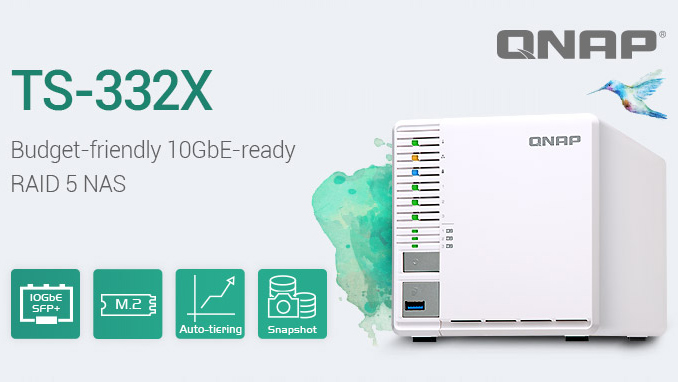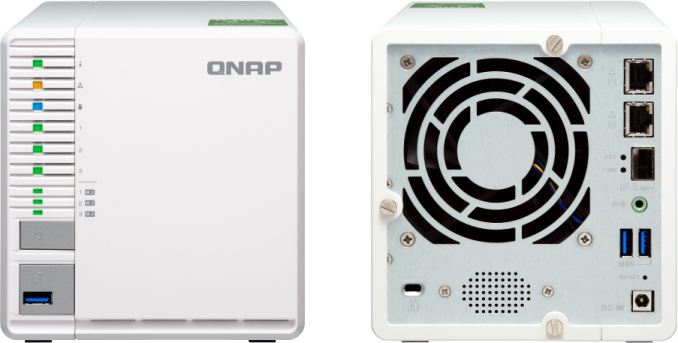QNAP Announces TS-332X Three-Bay NAS with 10 GbE
by Anton Shilov on September 5, 2018 3:00 PM EST
QNAP has announced its new three-bay NAS designed for SOHO market. The TS-332X also happens to be one of the industry’s first three-bay NASes that integrates a 10 GbE controller, so it should be able to offer rather high network performance for this market segment.
The QNAP TS-332X is based on Annapurna Labs’ Alpine AL-324 SoC (four ARM Cortex-A57 cores clocked at 1.7 GHz) outfitted with 2 or 4 GB of DDR4-2400 memory (upgradeable to 16 GB) as well as 512 MB of flash memory for caching. The NAS can accommodate three hot-swappable 2.5/3.5-inch SATA HDDs as well as three M.2-2280 SATA SSDs. The storage device officially supports hard drive of up to 12 TB capacity, but it is seemingly just a matter of time before QNAP certifies higher-capacity HDDs for this NAS. In the meantime, even three 12 TB hard drives and three 1 TB SSDs already provide a formidable amount of storage space for SOHO environments.
Like other modern NAS from QNAP, the TS-332X runs the company’s QTS 4.3.5 operating system, which supports a range of storage specific features, most notable RAID 5 and virtual JBOD. Other features include Qtier technology, which regularly places frequently used file/data on SSDs, encryption, snapshots, Qsync cross-platform file sharing (for Apple, Windows, and Linux machines), and so on.
One of the key selling points of the QNAP TS-332X is its set of connectivity options. The NAS has two GbE LAN ports, one 10 GbE LAN SFP+ header three USB 3.0 Type-A connectors, and one 3.5-mm line-out audio jack. In fact, the TS-332X will probably be one of the industry’s first entry-level NAS with 10 GbE support, which is an evidence that faster wired networks are getting more popular among device makers.
QNAP has already started shipments of the TX-332X with 2 GB and 4 GB of DDR4 memory. MSRPs of the devices are unknown, but their three-bay NAS are usually priced rather reasonably.
| QNAP TS-332X Specifications | |||
| TS-332X-2G | TS-332X-4G | ||
| CPU | Model | Annapurna Labs Alpine AL-324 | |
| Cores | four ARM Cortex-A57 cores | ||
| Freq. | 1.7 GHz | ||
| Encryption Accel. | ? | ||
| Memory | Speed | DDR4-2400, single-channel | |
| Capacity | 2 GB | 4 GB | |
| Bays | 3 × 2.5/3.5 bays | ||
| M.2 Slots | 3 × M.2-2280 | ||
| Storage interface | SATA 6 Gbps | ||
| Ethernet | 2×GbE, 1×10GbE (integrated) | ||
| Audio | 1 × audio out | ||
| USB | 3 × USB 3.0 Type-A | ||
| Other I/O | LEDs, buzzer, etc. | ||
| Dimensions | Height | 142 mm | 5.59" | |
| Width | 150 mm | 5.9" | ||
| Depth | 260.1 mm | 10.24" | ||
| PSU | 90 W external | ||
| OS | QNAP QTS 4.3.5 | ||
| MSRP | ? | ? | |
Related Reading:
- Synology 2018 NAS and Wi-Fi Lineup Sneak Peek
- Next-Gen NAS: An Interview with Alex Wang, CEO of Synology America
- QNAP Begins to Ship AMD Ryzen-Based TS-x77 Series NAS: 6, 8, 12 Bays
- QNAP TS-451+ SOHO NAS Review
Source: QNAP











22 Comments
View All Comments
Morawka - Wednesday, September 5, 2018 - link
yay now I can use my 10GbE ethernet port on my R6E motherboard.danielfranklin - Wednesday, September 5, 2018 - link
Maybe not, looks like an SFP+ port on the NAS.Can't believe their press release didn't mention the type of port...
Suspect it's SFP+ cause that's what the others with this chipset have but they want to get 10Gb headlines.
Or did Anandtech just leave it out?
Eitherway, I have 10Gb SFP+ ports and not BaseT so I don't care, not that I would buy an entery level NAS.
danielfranklin - Wednesday, September 5, 2018 - link
A side note, nice to see Annapurna Labs using an A57 core over the A15, welcome to 2015.I love the concept of their chips bringing enterprise features to cheap consumer chips. If they are going to do anything useful in the NAS market we need faster CPU cores though.
DanNeely - Wednesday, September 5, 2018 - link
SFP according to the linked QNAP page.HideOut - Wednesday, September 5, 2018 - link
"Sure to Fail Port" Why would the soho market want this? And this story failed to mention it while hyping a very pricey 3 bay. THREE bay. Wow.Samus - Thursday, September 6, 2018 - link
The SOHO market doesn't want this. Buy QNAP had to cheap out somewhere, and the best way to do it was cutting most of the cost of implementing 10Gbe while still technically having a 10Gbe-enabled device.I suspect there will be a lot of returns of these...
Black Obsidian - Thursday, September 6, 2018 - link
This seems like a fine fit for SOHO. SFP+ is still more common than 10GbE (especially on switches, if you only need 1-2 ports), and 3-bay is perfect for a RAID-5 of large drives. Rebuild times will suck, but it's not like your typical SOHO is going to spring for RAID-10 anyway.Hell, this isn't even bad for a lower-tier enterprise solution. I've got an 8-bay rackmount QNAP from 2009 that this thing could easily replace and provide more storage, better IO performance, and much higher network throughput.
rtho782 - Thursday, September 6, 2018 - link
This is fine. Few people have 10G RJ45 networks at home. Adding 10G to a desktop is easiest to do with an SFP NIC and a DAC.WatcherCK - Wednesday, September 5, 2018 - link
does QTS support for example PPoE (seeming you can download a ppoe app that lets you do just that) and does anyone use their NAS as a router as well? In theory the NAS operating system gets updated more often that ISP supplied routers...milkod2001 - Thursday, September 6, 2018 - link
What would be the best RAID config for 3 bay unit?